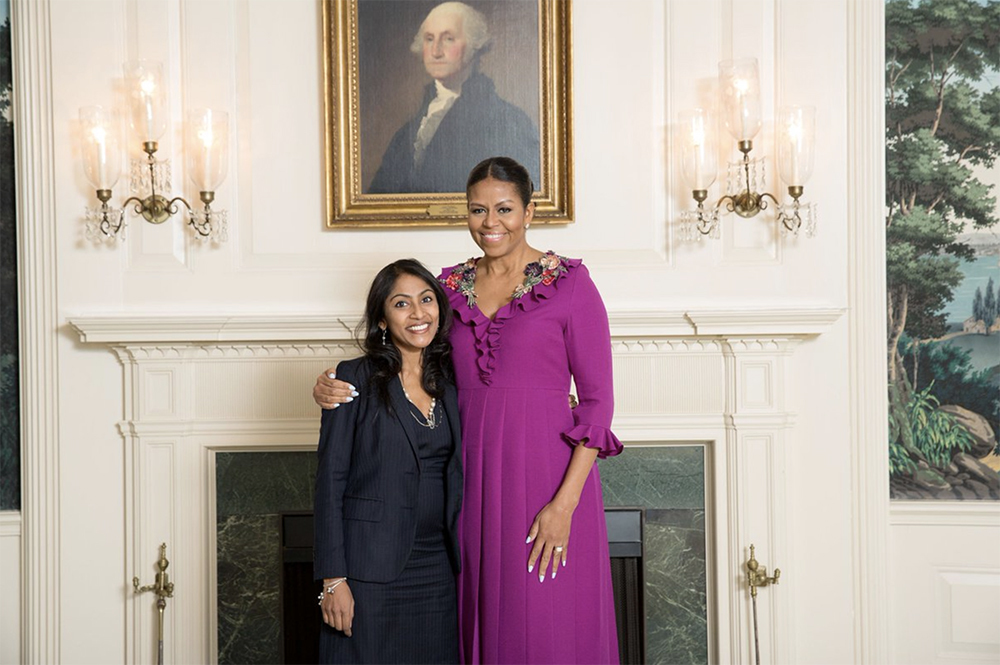
When news broke earlier this month that the popular Obama-era initiative Let Girls Learn may become a casualty of the most recent round of federal budgeting, one Baltimorean was especially jarred. As the former director of policy for former First Lady Michelle Obama, Krishanti Vignarajah helped the administration launch the initiative in 2015. We caught up with the Woodlawn High School graduate—who now runs her own company, Generation Impact, and is expecting her first child (a daughter)—to talk about the status of Let Girls Learn, and why it’s worth saving.
Let’s start with the basics. What is Let Girls Learn and how does it work?
It’s an initiative that President Obama and First Lady Michelle Obama launched in March of 2015 to support adolescent girls’ education, at home and abroad. We ultimately had seven agencies integrally involved, ranging from the State Department and our development agency, USAID, to the Department of Labor, Peace Corps and the Department of Agriculture.
Let Girls Learn supports girls’ education in three different ways. The first is through governmental support, everything from the building and renovation of schools to “second chance programs” for girls who’ve dropped out, to science and tech camps that bring together teenage girls from around the world. But we also appreciated that the U.S. couldn’t do it alone, and so we built an international coalition of governments ranging from Japan and Pakistan, to South Korea and the United Kingdom. But . . . even an international coalition of governments couldn’t solve a problem as large as nearly 100 million adolescent girls out of school worldwide, so we partnered with about 100 private sector companies and organizations, ranging from IBM, Johnson & Johnson, Girl Scouts, and Lands’ End, to universities like Georgetown and Cambridge to help us support girls in completing middle and high school.
What was your involvement in the creation of Let Girls Learn?
Mrs. Obama had been really quite moved by the Boko Haram kidnapping of over 200 girls in Nigeria. So she raised the question of what could we do to address this heartbreaking situation of girls getting kidnapped simply for going to school. Obviously, for both the President and the First Lady, the issue was personal, both because each of their success stories was in part driven by education, but also being the parents of two daughters, the incident hit close to home. We recognized that there was some ongoing programming that the U.S. government already supported, but that there was clearly a need to step up our efforts. So, I basically tried to figure out how could we address the issue of girls’ education, in a real and enduring way.
Why focus on girls not boys?
The reality that we see, both at home and all across the world, is that girls often fall behind—particularly when it comes to middle and high school. And so you end up seeing in some places dramatically lower completion and graduation rates for girls compared to boys. What we realized is that there’s no smarter investment in the future of America than investment in girls’ education.
How so?
When you talk about diverting resources from young girls, you’re really talking about divesting from the next generation of America’s leaders, the next generation of innovators, entrepreneurs, and astrophysicists. And they’re coming from everywhere—small towns, inner cities. They’re going to be the daughters of immigrants and working-class parents. So that’s why we knew that this was a priority. The investment in these girls is not just an investment in them, but an investment in their families, communities, and countries. We know, for example, that . . . for each additional year of high school, a girl’s earning potential goes up as much as 25 percent. Another example: Girls who attend school have healthier families. A Lancet study, for example, found that increasing girls’ education was responsible for more than half the reduction in child mortality between 1970 and 2009. I could go on and on.
So what does it cost the U.S. government per year to run this program?
We ended up investing $1 billion. Unfortunately, even that large amount is still far from what’s needed, because the tragic reality is that we still have 130 million girls out of school around the world.
One billion dollars sounds like a lot of money. For comparison’s sake, what are some other budget line items?
So, for example, our HIV/AIDS funding through PEPFAR, which President Bush created, receives about $7 billion. The State Department budget is about $50 to $51 billion, while the Defense Department budget is about $600 billion.
In terms of soft diplomacy, is Let Girls Learn one of the best investments we can make? You know, winning hearts and minds and all that.
Absolutely. [Secretary of Defense] General [James] Mattis has said this, ‘If you don’t fund the State Department fully, then I need to buy more ammunition ultimately.’ In some cases, it’s pennies on the dollar compared to the other investments we make. But you absolutely get the best bang for your buck.
As of today, it is unclear what the status of Let Girls Learn is. Initial reports suggested it was cut, then the State Department released a statement saying that the program will remain intact, but may get rebranded.
As you can imagine, I sort of scrambled to try to find out what was happening and what was potentially on the chopping block. I’ll tell you I think there is a lot of confusion about what exactly is being contemplated. In my mind, what is absolutely clear is that educating the next generation of women cannot become a casualty of partisan politics.
Do you worry that the Trump administration is just trying to avoid bad publicity here and fully intends to quietly end the initiative?
I realize that there’s always a chance with a new administration that an initiative like Let Girls Learn could have a bull’s-eye on it because it was so closely identified with the [former administration]. But . . . it would just make no sense. President [George W.] Bush, for example, launched the Millennium Challenge Corporation as a new approach to development and to substantially increase HIV/AIDS funding through PEPFAR. When we came into the White House, we realized the importance of these programs and actually increased funding for them. And the idea that something is bad just because it’s what a prior administration has done is at odds with the legacy of the White House.
On Thursday, Sen. Jeanne Shaheen (D-New Hampshire) introduced the Keeping Girls in School Act, which aims to preserve some aspects of Let Girls Learn, should the Trump administration decide to jettison the initiative.
Of course, I appreciate any effort to safeguard the significant achievements we made through Let Girls Learn. But it’s too bad if we need legislation to protect an initiative intended to ensure girls get an education—this issue should be above the fray of politics.
What if the Trump administration decides to keep the program but rebrands it? Why would changing that name and that brand be such a loss?
We launched Let Girls Learn in over 50 countries around the world. And as you can imagine, when Michelle Obama says ‘Let Girls Learn,’ people hear it and it means something. We had successful public service announcements that we put out that had everyone from Meryl Streep to John Legend making the case to let girls learn. Likewise, when we launched a social media campaign asking people to respond to the question ‘What did you learn in school?’ we got an overwhelming response. It ended up trending number one [on Twitter] domestically and number three internationally. We had everyone from David Cameron to Prince Harry to Beyoncé all supporting this cause. To rebrand and remove all of that would threaten to take away all of the awareness we’ve raised.
So, you’re saying there’s a lot invested in the brand already. It’d be like trying to rename Nike or something.
It’s like relabeling Coca-Cola and instead calling it Brown Fizzy Water. If you think there’s no cost to that, you’re failing to appreciate what Coca-Cola has built.
